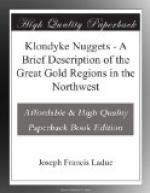“Forty Mile River is one hundred to one hundred and fifty yards wide at the mouth, and the current is generally strong, with many small rapids. Eight miles up is the so-called canon; it is hardly entitled to that distinctive name, being simply a crooked contraction of the river, with steep rocky banks, and on the north side there is plenty of room to walk along the beach. At the lower end of the canon there is a short turn and swift water in which are some large rocks; these cannot generally be seen, and there is much danger of striking them running down in a boat. At this point several miners have been drowned by their boats being upset in collision with these rocks. It is no great distance to either shore, and one would think an ordinary swimmer would have no difficulty in reaching land; but the coldness of the water soon benumbs a man completely and renders him powerless. In the summer of 1887, an Indian, from Tanana, with his family, was coming down to trade at the post at the mouth of Forty Mile River; his canoe struck on these rocks and upset, and he was thrown clear of the canoe, but the woman and children clung to it. In the rough water he lost sight of them, and concluded that they were lost: it is said he deliberately drew his knife and cut his throat, thus perishing, while his family were hauled ashore by some miners. The chief of the band to which this Indian belonged came to the post and demanded pay for his loss, which he contended was occasioned by the traders having moved from Belle Isle to Forty Mile, thus causing them to descend this dangerous rapid, and there is little doubt that had there not been so many white men in the vicinity he would have tried to enforce his demand.
“The length of the so-called canon is about a mile. Above it the river up to the boundary is generally smooth, with swift current and an occasional ripple. The amount of water discharged by this stream is considerable; but there is no prospect of navigation, it being so swift and broken by small rapids.
“From Forty Mile River to the boundary the Yukon preserves the same general character as between Fort Reliance and Forty Mile, the greatest width being about half a mile and the least about a quarter.
“Fifteen miles below Forty Mile River a large mass of rock stands on the east bank. This was named by Schwatka ‘Roquette Rock,’ but is known to the traders as Old Woman Rock; a similar mass, on the west side of the river, being known as Old Man Rock.
“The origin of these names is an Indian legend, of which the following is the version given to me by the traders;—




